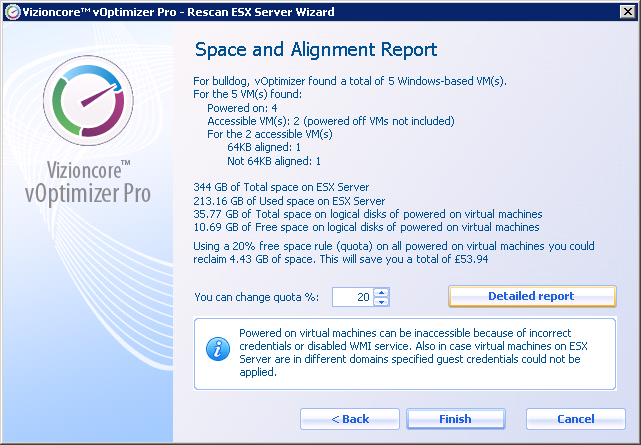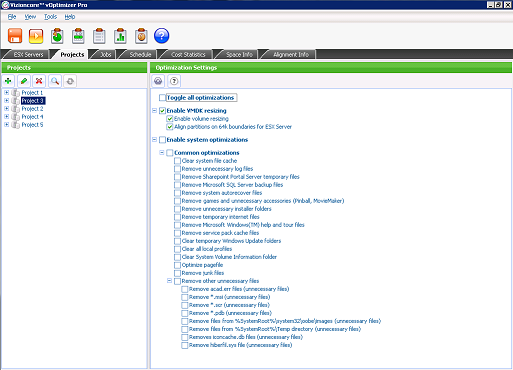In June Virtualisation tools specialist Vizioncore released vOptimizer Pro 2.2. The suite works with VMware ESX Server and helps manage the size and contents of the virtual disk (VMDK) files used by virtual machines (VMs) running Windows.
Administrators could use vOptimizer to ensure their VMDKs have just the right amount of free space. In many cases this would release unused server storage so it could be used by other VMs. In some cases it would prevent a VMDK becoming so full that the VM stopped working. Either way, vOptimizer Pro could pay for itself very quickly in organisations that have a large number of VMs. Future releases will probably add support for Linux VMs, Microsoft Hyper-V and VMware ESXi, none of which are supported by the current version.
According to The Hypervisor lab tests, the update smooths several wrinkles and adds a significant set of new reports and graphs.
One of the big new features in this release is a collection of new Space and Alignment reports which scan all the VMs in your environment and report on the potential disk capacity, performance and cost benefits of using the suite. For example, the Alignment report tells you whether virtual disk partitions are aligned to 64KB boundaries within the VMDKs. Overall these reports are a handy addition, but some are a little tricky to use. In particular, to run the 64KB Alignment scan on a VM we needed to provide vOptimizer Pro with the VM’s administrator level login credentials. In many cases we also needed to disable the VM’s Windows Firewall as well.
We recommend anyone thinking of buying the suite ask their software supplier to run this scan for them. As well as providing you with a comprehensive report showing the ROI from using the suite, this would also get your reseller to configure your VMs to work with vOptimizer Pro. If you have a lot of VMs this could save many hours fiddling with various Windows settings.
For this review we upgraded an existing vOptimizer Pro 2.1 installation to version 2.2. Although we needed to exit all our Vizioncore applications to complete the upgrade, things went smoothly and reboots were not required. When we started the new version we were pleased to see it was already populated with the details about our ESX servers and vCenter, which had been preserved from the previous version.
In testing for this review we optimized four VMs running Windows XP SP3. The idea behind the suite is to create projects, which are groups of VMs that should be optimized at about the same time and with similar optimization settings. For example, we created a project containing two VMs. We configured vOptimizer Pro to maintain 4GB free space on one and 20 percent free space on the other. As well as the space parameters, there’s a comprehensive range of Windows system optimizations, such as to clear the system file cache and remove temporary internet files. However, if enabled these optimizations are applied to all the VMs in a project.
Once created and tested, projects could be scheduled to run automatically on a regular basis. However, VMs are powered off during the optimization process, so you need to plan downtime carefully before scheduling vOptimizer Pro projects to run automatically.
Overall, the suite released about 20GB of SAN storage and aligned all four of our Windows partitions properly within their VMDKs, which should have improved the overall performance of our virtual infrastructure. This is because aligning VMs to 64KB boundaries reduces the number of disk read/write operations necessary when working with those VMs. Everybody using the host storage system benefits because the disk controller has to do less work. VMware published a white paper about 64KB alignment which is available here.
A few months ago we reviewed version 2.1 and were disappointed by vague error messages that cropped up when vOptimizer Pro encountered certain problems. It seems Vizioncore took that criticism to heart and has made an effort to make vOptimizer Pro’s error messages more helpful. For example, when we were unable to add a VM to a vOptimizer Pro project the new version told us to ensure the Windows Firewall on our VM had an exception for File and Printer sharing. In fact the problem was that File and Printer sharing was disabled, but the error message certainly pointed us in the right direction.
Unfortunately vOptimizer Pro didn’t work properly with one of our VMs. In this case the error message said “Volume requires more free space. Please increase the space quota and retry vOptimizer Pro operation”. This was quite misleading, as the VM had a 10GB VMDK with around 5GB free space. It turned out vOptimizer Pro ran successfully if we disabled the 64KB Alignment option. Having optimized the size of the VMDK file we then ran vOptimizer with the 64KB Alignment option enabled and the job completed properly.
When configuring our VMs to work with vOptimizer we also occasionally saw an error message saying “Virtual machine optimization was terminated for an unknown reason”. This was usually because File & Printer sharing was disabled, or there was no network connection between vOptimizer Pro and the VM. Other hiccups occurred if Remote Desktop was not enabled, if the Windows Firewall was configured to block RDP connections, or if Windows XP’s “Use simple file sharing” option was enabled.

